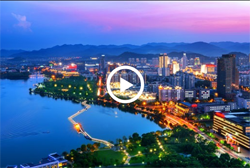Zhejiang riding wave to be maritime powerhouse
With a maritime area of some 260,000 square kilometers, Zhejiang province has multiple aquatic natural resources, including deep-water ports and rich oil and gas reserves, allowing it to be a pioneer in developing the maritime economy.
The State Council-the country's Cabinet-established China's first demonstration zone for the development of the maritime economy in Zhejiang in 2011, placing the province in the fast lane within a national maritime strategy.
A decade later, in 2021, the Zhejiang provincial government issued a guideline to develop the province's maritime economy over the 14th Five-Year Plan (2021-25) period.
According to the guideline, Zhejiang plans to build Ningbo and Zhoushan into maritime hubs, which can concentrate advantages and resources to develop the maritime economy. It's the first time the province has announced that these two cities will be developed into maritime hubs.
In the 1970s, construction of a major port began in Ningbo. Since then, the city has been transforming itself into a modern port city. In 2018, it was selected to be among 14 demonstration zones meant to develop the maritime economy.
Official data show total output value of the city's gross ocean product (GOP) reached 206.17 billion yuan ($31 billion) in 2021, accounting for 14.1 percent of its gross domestic product and 20.7 percent of Zhejiang's GOP.
Speeding up the growth of related industries is an efficient measure to develop the maritime economy in Ningbo.
In April, Ningbo Rixing Foundry Co Ltd, a manufacturer of marine engineering equipment, was included in the list of the city's "future plants".
In 2021, Zhejiang launched a campaign to build future plants, which refer to plants that excel in the integration of new-generation information technologies in the advanced manufacturing sector.
An offshore wind-farm industrial park, with a total investment of more than 10 billion yuan, is under construction in the city's Xiangshan county, and is expected to be completed in August.
It will integrate emerging industries and promote the green and intelligent development of the maritime economy.
The port is also incorporated into the city's overall layout of improving the maritime economy.
In March, the Ningbo municipal government unveiled a five-year development plan for its maritime economy development, setting a goal of becoming a global maritime economy hub by 2035.
According to the plan, more efforts will be made to reinforce Ningbo Zhoushan Port's position as a world-leading port.
Similar plans were launched by the coastal Zhoushan municipal government as well. It specified in its five-year development plan that Zhoushan will build maritime economy hubs with Ningbo.
Yuan Jiajun, Party secretary of Zhejiang province, called for promoting the maritime economy to accelerate the development of the province during his visit in Zhoushan in April.
The two cities also unveiled 42 tasks for this year to further promote integrated development, including facilitating the Ningbo-Zhoushan Integrated Cooperation Pilot Zone, speeding up the integrated construction of Ningbo Zhoushan Port, and pushing ahead with opening up.
Ningbo Zhoushan Port ranked top in 2021 rankings among 50 global ports with cargo throughputs of 1.22 billion metric tons, topping the global rankings for the 13th straight year, said the Shanghai International Shipping Institute (SISI).
Zhoushan Port is among the top 3 ports in a list of oil and gas-focused ports in the country, which was recently released by Sinopec.
In 2021, a section of Zhoushan Port handled 133 million tons of oil, natural gas and related products, making it the largest port in the nation in terms of oil and gas throughput.
Development of the port depends on new measures launched after the establishment of the China (Zhejiang) Pilot Free Trade Zone.
In 2017, a section of the Zhejiang FTZ was established in Zhoushan and its outlying islands. Since then, Zhoushan area of the Zhejiang FTZ has been forming a complete industrial chain for the oil and gas industry.
Over the past five years, the green petrochemical base in Zhoushan has become the largest chemical refining integration project in the country after its second phase was completed at the end of 2021.
Zhejiang Petroleum and Chemical Co Ltd, the operator and investor of the green petrochemical base, processed 26.52 million tons of crude oil and generated 139 billion yuan in revenue last year.
Zhoushan now has the largest oil product storage and transportation base and the largest liquefied natural gas receiving center in the country.
As more LNG receiving stations will be constructed in the city, Zhoushan will supply LNG not only to the Yangtze River Delta region, but also to Anhui, Jiangxi and other provinces along the river.
Contact the writers at mazhenhuan@chinadaily.com.cn


 Shaoxing Showdowns
Shaoxing Showdowns Zhejiang: A Decade of Progress
Zhejiang: A Decade of Progress Shaoxing in expats' eyes
Shaoxing in expats' eyes